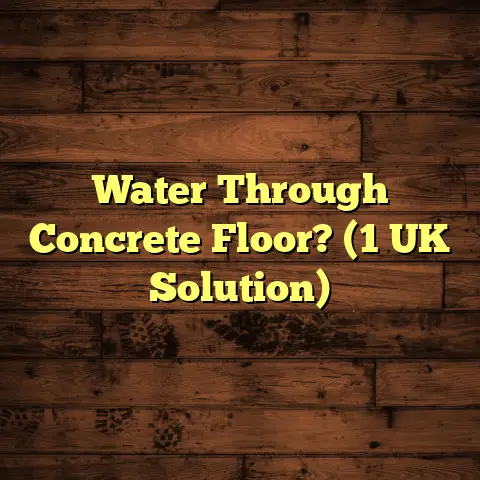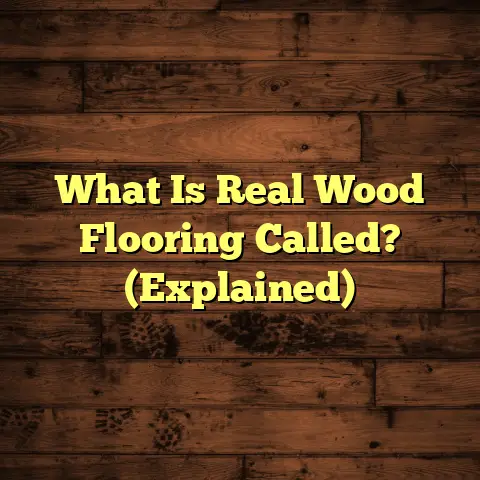What To Look For In LVP? (2 Red Flags Appear!)
(2 Red Flags Appear!)
Remember that old, worn-out carpet? The one in your living room that’s seen better days?
Or maybe it’s scratched hardwood, dull and lifeless, making your space feel…blah?
I’ve seen it a thousand times. Families struggling to enjoy their homes because the flooring just isn’t cutting it.
Faded colors, impossible stains, and a general lack of warmth. It’s no way to live!
But imagine this: the same room, transformed. Rich, vibrant LVP (Luxury Vinyl Plank) flooring underfoot.
The texture mimics real wood, the colors complement your decor, and suddenly, the room feels inviting.
It’s easy to clean, comfortable to walk on, and the whole family can finally relax and enjoy the space.
That’s the power of LVP.
But choosing the right LVP is crucial. And believe me, I’ve seen enough flooring disasters to know what red flags to look for.
Let’s dive in and make sure you get it right!
Section 1: Understanding Luxury Vinyl Plank
So, what exactly is LVP? And why is everyone talking about it?
Luxury Vinyl Plank is a type of flooring designed to mimic the look of natural materials like wood or stone.
It’s made from synthetic materials, primarily PVC (polyvinyl chloride), making it incredibly durable and water-resistant.
Its popularity has exploded in recent years, and for good reason. According to a report by Grand View Research, the global luxury vinyl flooring market was valued at $32.65 billion in 2023 and is expected to grow. (Source: Grand View Research)
I believe that LVP is projected to continue growing in popularity.
Why? Several key benefits:
- Durability: LVP can withstand heavy foot traffic, spills, and scratches far better than many traditional flooring options.
- Water Resistance: Unlike hardwood, LVP is highly resistant to water damage, making it ideal for bathrooms, kitchens, and basements.
- Affordability: LVP generally costs less than hardwood or tile, both in terms of materials and installation.
- Aesthetic Versatility: LVP comes in a huge range of styles, colors, and textures, mimicking everything from rustic wood to modern stone.
How is LVP constructed? It’s all about the layers:
- Wear Layer: This is the top layer that protects the plank from scratches, stains, and wear. The thicker the wear layer, the more durable the flooring.
- Design Layer: This layer features the printed image of wood, stone, or other design. High-quality LVP uses realistic images for a more authentic look.
- Core Layer: The core provides stability and support. It’s often made of PVC or a composite material.
- Backing Layer: This bottom layer provides cushioning and helps to absorb sound.
Do you see why LVP is becoming so popular? It offers a fantastic combination of practicality and style.
But not all LVP is created equal. And that’s where things can get tricky.
Section 2: Key Features to Evaluate
Okay, let’s get down to brass tacks. What should you really be looking for when choosing LVP?
I’ve narrowed it down to five key features that can make or break your flooring experience.
1. Thickness:
Thickness matters. A thicker plank generally means a more durable and comfortable floor.
Think about it: a thicker plank can better absorb impact and resist dents. It also provides a more solid feel underfoot.
I typically recommend a thickness of at least 5mm for residential use. For high-traffic areas or commercial spaces, you might want to go even thicker.
2. Wear Layer:
This is the most important factor. The wear layer is the clear, protective coating on top of the design layer.
It’s measured in mils (thousandths of an inch). The thicker the wear layer, the more resistant your floor will be to scratches, scuffs, and stains.
Here’s a general guideline:
- 6-12 mil: Suitable for light residential use (bedrooms, guest rooms)
- 12-20 mil: Good for general residential use (living rooms, kitchens)
- 20+ mil: Ideal for high-traffic areas or commercial use
Don’t skimp on the wear layer! It’s worth investing in a thicker wear layer to extend the life of your flooring.
3. Design and Texture:
LVP has come a long way in terms of design. You can find incredibly realistic wood and stone visuals.
Look for LVP with embossed-in-register (EIR) texture. This means the texture aligns with the printed image, creating a more authentic look and feel.
I’ve seen some LVP that looks so real, it’s hard to tell the difference from actual hardwood!
4. Installation Method:
There are two main installation methods for LVP: click-lock and glue-down.
- Click-Lock: This is a floating floor system where the planks lock together. It’s generally easier for DIY installation.
- Glue-Down: This involves adhering the planks directly to the subfloor. It provides a more stable and permanent installation.
Which is better? It depends on your specific needs and preferences.
Click-lock is great for ease of installation and can be installed over existing floors (with proper preparation). Glue-down is more stable and can be a better choice for areas with high moisture or heavy traffic.
5. Warranty:
Always check the warranty! A good warranty can protect you against manufacturing defects and premature wear.
Read the fine print carefully. Warranties typically cover things like fading, staining, and delamination.
Pay attention to the length of the warranty and what it specifically covers. A longer warranty is generally a sign of a higher-quality product.
Are you starting to get a feel for what to look for? Remember, it’s all about finding the right balance of durability, aesthetics, and price.
Now, let’s talk about those red flags…
Section 3: Red Flag #1 – Poor Quality Materials
This is where things can go south quickly. Poor quality LVP can lead to a whole host of problems down the road.
I’ve seen it happen time and time again. Homeowners try to save a few bucks by going with the cheapest option, only to regret it later.
So, what are the signs of low-quality LVP?
-
Thin Wear Layers: As I mentioned earlier, the wear layer is crucial. If it’s too thin, it will wear down quickly, leaving your floor vulnerable to scratches and stains.
I’ve seen wear layers as thin as 3 mil on some budget LVP. That’s simply not enough for most homes. * Inconsistent Colors or Textures: Poor manufacturing can result in inconsistent colors or textures across the planks. This can make your floor look cheap and unnatural. * Lack of Certifications: Look for certifications like FloorScore or Greenguard. These certifications ensure that the LVP meets certain standards for indoor air quality and safety.
I always recommend checking for certifications. It’s a good way to ensure that you’re getting a safe and healthy product.
What are the long-term cost implications of choosing low-quality LVP?
- Premature Wear: You’ll likely need to replace the flooring much sooner than you would with a higher-quality product.
- Increased Maintenance: Low-quality LVP is often more difficult to clean and maintain.
- Reduced Home Value: Cheap flooring can detract from the overall value of your home.
I know it can be tempting to save money upfront, but trust me, it’s worth investing in quality LVP. You’ll save money in the long run and enjoy your flooring for years to come.
Section 4: Red Flag #2 – Misleading Claims
The flooring industry, like any other, is full of marketing gimmicks and exaggerated claims.
It’s important to be a savvy consumer and not fall for these traps. I want you to be able to smell the BS from a mile away!
Here are some common misleading claims to watch out for:
-
“Waterproof” vs. “Water-Resistant”: This is a big one! Many LVP products are marketed as “waterproof,” but that’s not always accurate.
LVP is generally water-resistant, meaning it can withstand spills and moisture to some extent. However, if water sits on the surface for an extended period, it can seep through the seams and damage the subfloor.
“Waterproof” implies that the flooring is completely impervious to water, which is rarely the case.
I always advise my clients to clean up spills promptly, regardless of whether the LVP is marketed as “waterproof” or “water-resistant.” * Claims of Extreme Durability: Some manufacturers make outrageous claims about the durability of their LVP, without providing any real evidence.
They might say things like “scratch-proof” or “dent-proof,” which is simply not true. All flooring is susceptible to some degree of wear and tear.
Be wary of claims that seem too good to be true. Always ask for specifics about the wear layer thickness and the results of independent testing.
How can you verify these claims?
- Check for Third-Party Certifications: Look for certifications like FloorScore or Greenguard, which I mentioned earlier. These certifications indicate that the product has been tested and meets certain standards.
- Read Customer Reviews: See what other people are saying about the product. Are they happy with its durability and performance?
- Ask for Samples: Most manufacturers will provide samples of their LVP. Take advantage of this and test the sample yourself. Try scratching it with a key or dropping a heavy object on it to see how it holds up.
Don’t just take the manufacturer’s word for it. Do your own research and make an informed decision.
Section 5: Comparing Brands and Options
Okay, so you know what to look for and what red flags to avoid. Now, let’s talk about specific brands and options.
There are a ton of LVP brands out there, each with its own strengths and weaknesses. Here are a few of the major players:
- Shaw Floors: Shaw is one of the largest flooring manufacturers in the world. They offer a wide range of LVP products, from budget-friendly options to high-end luxury planks.
- Armstrong Flooring: Armstrong is another well-known brand with a long history in the flooring industry. They offer a variety of LVP styles and colors.
- Mohawk Industries: Mohawk is a leading manufacturer of residential and commercial flooring products. They offer a diverse selection of LVP, including waterproof options.
- COREtec: COREtec is known for its innovative waterproof LVP products. Their planks feature a unique core structure that makes them highly resistant to water damage.
How do you research and compare products effectively?
- Read Customer Reviews and Expert Opinions: Check out online reviews and see what other people are saying about the products you’re considering. Look for reviews from reputable sources like Consumer Reports or flooring industry publications.
- Visit Showrooms: Go to a local flooring showroom and see the products in person. This is a great way to get a feel for the texture and color of the LVP.
- Ask for Samples: As I mentioned earlier, always ask for samples. Take the samples home and test them in the intended space. See how they look in different lighting conditions and how they coordinate with your existing decor.
When comparing products, it’s important to assess long-term value versus initial cost.
A cheaper product might seem appealing at first, but it could end up costing you more in the long run if it wears down quickly or requires frequent repairs.
I always tell my clients to focus on quality and durability. It’s better to invest in a higher-quality product that will last for years than to save a few bucks on something that will need to be replaced in a few years.
Section 6: Conclusion and Final Thoughts
Choosing the right LVP flooring can transform your space and make your home more comfortable and enjoyable.
But it’s important to be informed and vigilant. Don’t fall for marketing gimmicks or settle for low-quality materials.
Remember these key points:
- Pay attention to the wear layer. The thicker, the better.
- Look for certifications like FloorScore or Greenguard.
- Be wary of misleading claims like “waterproof” or “scratch-proof.”
- Do your research and compare products from different brands.
- Assess long-term value versus initial cost.
I’ve seen firsthand how the wrong flooring choice can lead to frustration and additional expenses. But I’ve also seen how the right choice can completely transform a home.
So, take your time, do your homework, and choose wisely. Your floors will thank you for it!





